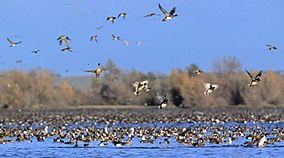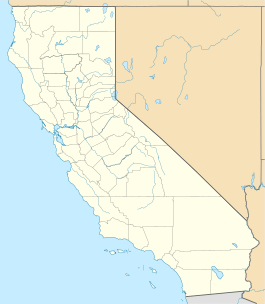Butte Sink Wildlife Management Area facts for kids
Quick facts for kids Butte Sink Wildlife Management Area |
|
|---|---|
|
IUCN Category IV (Habitat/Species Management Area)
|
|

Ducks at Butte Sink Wildlife Management Area
|
|
| Location | Colusa, Butte, and Sutter Counties, California United States |
| Nearest city | Colusa, California |
| Established | 1980 |
| Governing body | U.S. Fish and Wildlife Service |
| Website | Butte Sink Wildlife Management Area |
The Butte Sink Wildlife Management Area (WMA) is a special place in California. It covers parts of Colusa, Butte, and Sutter Counties. This area is made up of important wetlands. It is managed by the U.S. Fish and Wildlife Service. The WMA is part of the larger Sacramento National Wildlife Refuge Complex. It is important to know that this area is not open to the public.
Contents
What is the Butte Sink WMA?
The Butte Sink Wildlife Management Area is a large area of wetlands. It covers about 18,000-acre (73 km2) of land. A big part of this land, about 10,311 acres (41.73 km2), is still privately owned. However, the landowners have agreed to keep these areas as wetlands forever. This agreement is called a "conservation easement." It helps protect the natural habitat. These private lands are also closed to visitors.
The Butte Sink Unit
A smaller part of the WMA, about 733-acre (2.97 km2), was bought by the government in 1980. This area is called the "Butte Sink Unit." It used to be known as the Butte Sink National Wildlife Refuge. This unit was created specifically to protect wetlands for birds that spend their winters there. Like the rest of the WMA, the Butte Sink Unit is also closed to the public.
Why is Butte Sink WMA Important?
The main goal of the Butte Sink Wildlife Management Area is to help wildlife. It provides a safe place for many different animals and plants.
Helping Wintering Waterfowl
One of the biggest jobs of the WMA is to provide food and a resting place for ducks and geese. These birds fly south for the winter. The Butte Sink is a crucial stop for them. It helps them survive the cold months.
Protecting Rare Animals
The WMA also works to protect special animals. These include endangered, threatened, or sensitive species of concern. These are animals that are at risk of disappearing forever. The WMA helps make sure they have a safe home.
Supporting Migratory Birds
Many birds travel long distances every year. These are called "neotropical migratory land birds." The Butte Sink provides important habitat for them. It helps them rest and find food during their long journeys.
Keeping Nature Diverse
The WMA aims to keep nature healthy and full of different kinds of life. This means protecting all the plants and animals that live there. It helps keep the natural balance of the ecosystem.
Preventing Crop Damage
Sometimes, large groups of birds can eat crops on nearby farms. This is called "crop depredation." By providing plenty of food and resting areas within the WMA, it helps keep the birds away from farmers' fields. This protects both the birds and the crops.
Wildlife in the Butte Sink
The Butte Sink is home to a huge number of birds, especially in winter. It often hosts over 300,000 ducks and 100,000 geese. These numbers show how vital this area is for these birds.
Wetlands are Disappearing
Over the last 100 years, about 95 percent of the wetlands in California's Central Valley have been lost. This means there are fewer places for waterfowl to live. Because of this, birds rely more and more on the few remaining wetlands, like those in the Sacramento Valley and the Butte Sink. Protecting these areas is more important than ever.



